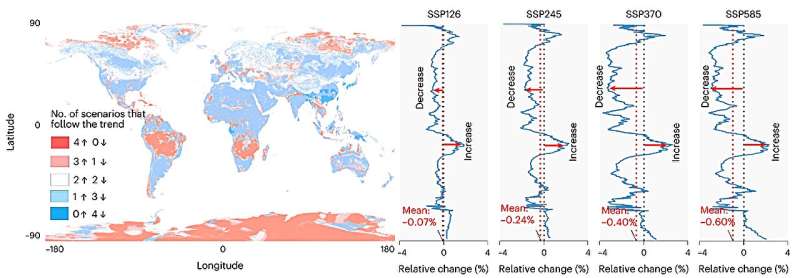This article has been reviewed according to Science X's editorial process and policies. Editors have highlighted the following attributes while ensuring the content's credibility:
fact-checked
peer-reviewed publication
trusted source
proofread
Researchers predict climate change-driven reduction in beneficial plant microbes

Bacteria that benefit plants are thought to be a critical contributor to crops and other ecosystems, but climate change may reduce their numbers, according to a new study by an international team of researchers. They have published their findings in Nature Food.
The collaboration, including Francisco Dini-Andreote, professor of plant science at Penn State, characterized the abundances and distributions of plant beneficial bacteria (PBB) from soils collected across the globe. The researchers then modeled how these microbial communities may be impacted by fossil-fuel dependent climate change in the next century.
Leveraging existing data from the Earth Microbiome Project, the researchers identified microbes that may provide services to plants such as biocontrol or limiting impacts of pathogens, plant growth promotion and stress resistance. Such services implicate these bacteria as key components of productive agroecosystems, which primarily yield food.
"Plants are colonized by a diverse set of microbes on and in their roots, leaves and stems," Dini-Andreote said. "These plant-associated microbiomes represent an extension of the plant metabolic capacity—often termed 'the second genome of plants.'"
This notion echoes the hologenome concept, which considers the total set of genes contained by an organism and its associated microbiome to make inferences about organismal health and evolution. According to the researchers, characterizing the biogeography of PBB sets the stage for understanding the variables that govern global microbial community patterns and predicting their future in a rapidly shifting world.
Their analysis revealed several trends in PBB diversity, including higher levels of diversity and richness in lower latitudes, with the highest concentration in North America and Africa. A total of 396 genera, the taxonomic rank above species level, were identified.
The researchers found that local environmental variables—climate, in particular—were strong predictors of PBB community composition, likely exerting strong influences on PBB distribution. This suggests that climate influences what bacteria are found where and in what proportion.
To investigate how PBB abundances and distributions may change over the next century, the researchers modeled several climate scenarios based on projections from the Intergovernmental Panel on Climate Change.
Under the fossil-fueled development scenario, which assumes tripled greenhouse gas emissions by 2075, the model predicted that PBB associated with biocontrol and stress resistance would decline by 0.60% in 80% of global regions, as opposed to 0.07% under a Sustainability scenario. Under all scenarios, middle-latitude regions are projected to experience steady declines, whereas increases in PBB are anticipated in polar and equatorial regions.
Dini-Andreote noted that predictive studies such as this are broadly impactful but cautioned that models are limited and must be experimentally validated. For instance, in controlled settings, plant-soil systems can be exposed to warming or drought conditions, after which researchers can evaluate shifts based on the impact and adaptation of PBB communities relative to controls.
In other words, experimentation is required to know how PBB will be affected under climate-related stress, and what levels of PBB decline will have a critical impact on plant health.
In addition to informing community ecology research, the researchers said they hope to spark agricultural innovation and applications for increased food security. But those innovations are unlikely to include soil probiotics to restore diminished PBB.
Dini-Andreote said that such bioinoculants can often have several shortcomings such as requiring continual application. Additionally, only a small fraction, about 5% to 10%, of soil microbes can be cultured, which limits the development of full-spectrum probiotics.
Dini-Andreote offered an alternative.
"By advancing our understanding of how these distinct PBB survive in association with plants, for instance in the plant rhizosphere, we can develop strategies to engineer crops to produce compounds that feed these beneficial microbes," Dini-Andreote said.
Through this approach, the researchers suggested, plants could recruit beneficial bacteria with no need for the external input of probiotics. The potential impacts of applications like this are untold, Dini-Andreote said, but underscore the importance of exploring the rapidly advancing frontier of microbiomes.
"We hope this paper serves as a catalyst for more empirical studies of PBBs," Dini-Andreote said.
Seth Bordenstein, director of the One Health Microbiome Center and professor of biology and entomology who holds the Dorothy Foehr Huck and J. Lloyd Huck Endowed Chair in Microbiome Sciences, echoed the sentiment and praised the work.
"This high-profile research is a testament to Dr. Dini-Andreote's impactful and original research on plant-microbe interactions in a One Health context, spanning soil, plant and human health," Bordenstein said. "His vision for plant hologenome studies and integration with global environmental and geographic data is not only driving textbook-level knowledge, but it also raises the alarm on evidence-backed sustainability challenges."
More information: Pengfa Li et al, Fossil-fuel-dependent scenarios could lead to a significant decline of global plant-beneficial bacteria abundance in soils by 2100, Nature Food (2023). DOI: 10.1038/s43016-023-00869-9
Journal information: Nature Food
Provided by Pennsylvania State University




















